Categories
Tags
-
#Safe Power Distribution
#Industrial Power Solutions
#Energy Efficiency
#Smart Power Hubs
#Modular Electrical Systems
#Weatherproof Enclosures
#Durable Material Engineering
#Seamless Integration
#Modern Industrial Aesthetics
#Sustainability
#EnergyEfficiency
#IndustrialSafety
#OutdoorElectricalSolutions
#CustomizablePowerDistribution
#CustomizableOutdoorElectricalDistributionPanel
#IndustrialSocketBox
#IndustrialSocketBoxManufacturer
#Nante
#outdoor electrical distribution panel
#Outdoor Electrical Distribution Panel Manufacturer
#Nante Outdoor Electrical Distribution Panel
#Industrial Socket Box
#Industrial Socket Box Manufacturer
#Nante Industrial Socket Box
#Concealed Socket Solutions
#Industrial Concealed Socke
#Nante Industrial Concealed Socket
#Industrial Plug
#Industrial Plug Manufacturer
#Nante Industrial Plug
#Portable Distribution Box
#Portable Distribution Box Manufacturer
#Nante Portable Distribution Box
#distribution Socket Box
#Nante distribution Socket Box
#Socket Box
#Pet Hair Remover Comb
#Pet Hair Remover Comb Manufacturer
#Tallfly Pet Hair Remover Comb
#Industrial Concealed Socket
#Nante Electrical Socket Box
#Electrical Socket Box Manufacturers
#Electrical Socket Box
Archives
Avoid Overloads With Clear Wattage Planning and Circuit Labels
-
Posted by Lars xinnyi - Filed in Technology - #Portable Distribution Box #Portable Distribution Box Manufacturer #Nante Portable Distribution Box - 56 views
When managing power for mobile workshops or outdoor events, selecting the right Portable Distribution Box is only half the challenge. Equally important is understanding how wattage and circuits work together to prevent overloads. Recent shifts toward remote workstations and portable medical stations have increased reliance on these compact hubs. Knowing how to calculate power draw and distribute loads wisely helps avoid tripped breakers and ensures smooth operation under varied demands.
Every outlet on a distribution unit is connected to a specific circuit with a fixed current rating. Exceeding that limit causes the protective device to trip, cutting power to all connected equipment. To plan effectively, start by identifying the wattage of each device you intend to power. Multiply volts by amps to get watts, then add the total. Comparing that figure to the combined capacity of your box's circuits reveals if any adjustments are needed before plugging in.
Disaster response teams and outdoor production crews often work with lighting rigs, sound mixers and communication tools that vary widely in power needs. Spotlights may draw large currents at startup, while LED panels use less energy continuously. A Portable Distribution Box with multiple circuits lets you isolate high draw items on their own feed. This technique keeps sensitive electronics on a separate circuit, reducing interference and preventing one device from shutting down the rest.
Balancing load also improves heat management. When a single circuit bears too much current, wiring can warm up, shortening component life or even creating fire hazards. In contrast, spreading devices evenly across available circuits lowers resistance at each terminal and helps maintain cooler temperatures inside the enclosure. For instance, connect heaters or battery chargers to one circuit while running laptop stations and monitors on another.
Modern distribution units may include indicators or circuit labels that make it easier to track usage. Some models feature reset switches for each circuit, so you can restore power quickly after an overload event without shutting down the entire box. When one feed trips, unplug devices on that line and press the reset button. This targeted recovery lets your operation continue with minimal downtime.
Safety extends beyond total wattage. Always account for startup currents, which can temporarily exceed running draw. Motors, compressors and some pumps demand extra energy the moment they start. To prevent nuisance trips, allocate these devices to circuits that can handle inrush currents or stagger their activation times. Waiting a few seconds between starting each motor can make a difference in avoiding overloads.
Proper cable selection matters too. Using an undersized cord for a high draw tool increases voltage drop and heat buildup. Match cable gauge to the current rating of each circuit and the distance from the distribution unit. Longer runs require thicker cables to maintain safe performance. Many field technicians carry a selection of cables and adapters to adjust on site as needed.
Routine inspection and testing help keep everything in order. Before deployment, check that circuit breakers or fuses are correctly sized and that all connections are tight. A loose terminal can raise resistance and trigger a trip even under normal load. Dust and moisture inside the unit also affect performance. Regular cleaning and drying of the enclosure interior reduce the risk of faults in demanding environments.
Training for all users ensures that everyone understands how to use the distribution unit safely. Posting simple reference charts near the box showing which outlets feed which circuits guides newcomers and helps avoid accidental overload. When multiple teams share the same Portable Distribution Box, clear communication about device placement and power needs keeps equipment running smoothly.
By mastering wattage calculations and load distribution, you can make full use of a Portable Distribution Box without interruption. Whether you are powering a temporary office, setting up a field clinic or running outdoor sound and lighting, these practices help you maintain reliable power. For a range of flexible distribution units and expert advice on selecting the right model for your application, visit https://www.nante.com/ . Discover solutions designed to support your power management needs and keep your projects moving forward.
